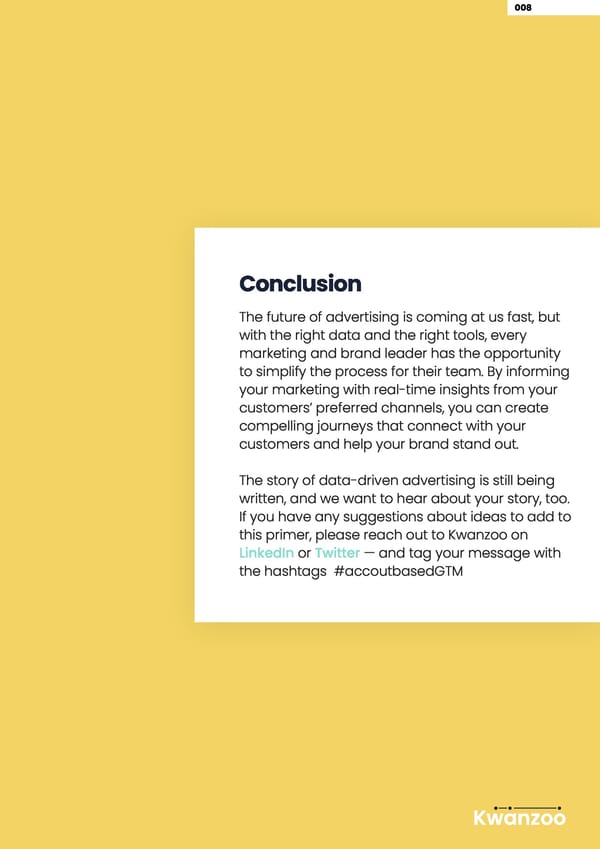4. Data Driven Advertising
Kwanzoo Data Driven Advertising Navigating to a future with First-Party Only Advertising KK
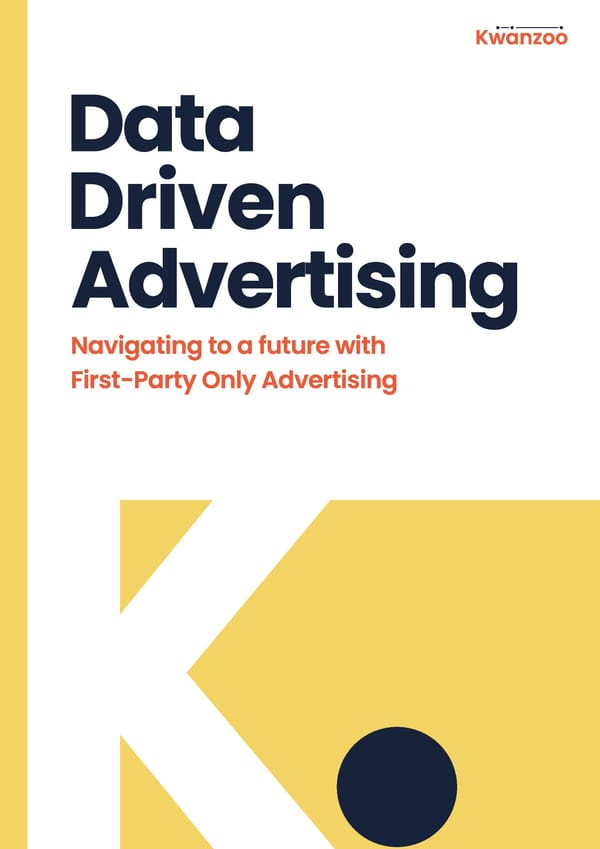
001 Chapter 1 How to understand your B2B buyers through data Chapter 2 How to create a buyer- CCuussttoommeerr eexxppeeccttaattiioonnss aarree centric advertising strategy eevvoollvviinngg aass rraappiiddllyy aass tthhee ddiiggiittaall cchhaannnneellss aanndd ppllaattffoorrmmss wwee uussee ttoo rreeaacchh BB22BB bbuuyyeerrss ttooddaayy.. Chapter 3 ” How to launch and measure cross-channel campaigns Navigating to a future with 1st Party-Only Advertising The world is changing faster than ever, and so is the world of advertising. Customer expectations are evolving as rapidly as the digital channels and platforms we use to reach B2B buyers today. New privacy regulations like GDPR and CCPA, have only added to the uncertainty faced by global enterprises that use advertising to reach their target accounts.. In response to these changes, marketers’ top three priorities are now around innovating, engaging customers in real time, and complying with privacy regulations. But no matter what changes about advertising, there’s one thing that won’t change — and that’s the fact that successful advertising is (and has been for the last century) about testing and measuring data so you can understand your customers and have the most relevant conversations possible. With today’s data and technology, marketers have the opportunity to understand their customers better than ever. This field guide is your introduction to the data-driven future of advertising for B2B companies, from a B2B buyer-centric strategy development to cross-channel campaign launch and data analysis. Kwanzoo
002 Chapter 1: How to understand your B2B buyers through data Most businesses collect B2B buyer data in some way, but not all businesses proactively use data to understand their buyers and make them feel known and seen in helpful ways. When your prospect and customer data is connected together through the right technology, it can be a treasure trove of insights that can help you build better journeys for your prospects as they are researching your products and solutions, as well as your customers as they get more invested with your company. TThhaatt mmiigghhtt bbee wwhhyy 7788%% ooff mmaarrkkeetteerrss ddeessccrriibbee tthheeiirr bbuuyyeerr eennggaaggeemmeenntt aass ddaattaa--ddrriivveenn.. Start every buyer relationship with consent. Data privacy laws are evolving worldwide, and what was appropriate a few years ago may now give rise to complaints or even legal action. Respecting privacy and providing transparency are key to building trusting, empathetic buyer relationships through data your audience wants you to have. That’s why the world’s most popular internet browsers are phasing out support for third-party cookie-based data collection, and leading marketers are now shifting their focus to first-party data — which B2B prospects and customers give companies permission to collect directly. Fifty-eight percent of B2B buyers are willing to share their information if they’re comfortable with the value they receive in exchange, so many marketers are taking steps to meet and even exceed today’s privacy regulations. To do this yourself, you can communicate with prospects to ensure consent and use data privacy tools that add consent forms and steps to your buyer journeys. Just remember that the privacy landscape is changing fast, so it’s best to use tools that can help you adapt quickly. Kwanzoo
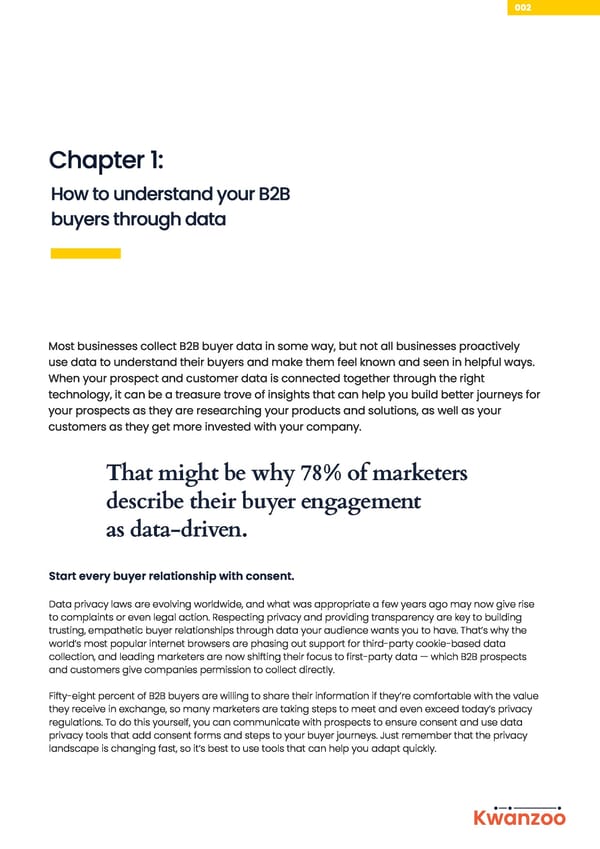
003 GGTTMM ppllaattffoorrmmss ccaann ccoonnnneecctt tthhee ccrriittiiccaall ddoottss bbeettwweeeenn MMAAPPss,, CCRRMMss,, DDMMPPss,, aanndd CCDDPPss ” Step away from silos and connect buyer data. The data-driven future of advertising is only possible through data unification. Today’s leading B2B marketers are using marketing automation to manage their engagement with known buyers (contacts) through marketing emails. Some companies then augment the marketing automation-powered buyer engagement with anonymous buyer engagement data collected through data management platforms (DMPs). Other companies are combining MAPs with customer profiles stored in customer data platforms (CDPs) to create a single view of all known buyer activity across every channel. Traditional DMPs and CDPs often fall short for B2B companies, due to their lack of understanding of the specific nuances of B2B data taxonomies (accounts, buyers, buyer personas, buying groups, account- based audience segments, and more). Newer B2B Go-to-Market (GTM) platforms provide some critical capabilities while “connecting the dots” between MAPs, CRMs, DMPs, and CDPs at B2B companies. Some GTM platforms are additionally addressing the specific requirements around 1st party cookie collection across all online channels, with support for activation of these 1st party cookie audiences through media buying platforms (DSPs) of programmatic ads. In a nutshell, these platforms and tools collectively are the key to data-driven advertising at global scale. To start unifying data sources, it’s important for marketers to work with other departments such as sales and customer success to evaluate all relevant data across the company. You may even need to reach out to outside agencies and partners to get a handle on all your past customer interactions. Once you know where your data is, it’s just a matter of accurately organizing and uploading it to your B2B GTM, DMP and CDP platforms. With dedicated oversight and a little help from B2B GTM experts who also truly understand your GTM and data strategy, you’ll be ready to use unified data to build connected customer experiences before you know it. Lay a data foundation. Successfully connecting your target account, prospect and customer data starts with a clear strategy. This means you need to start with a plan and decide what kind of data you need, how you want to segment your audiences, and how you want to use data to personalize your buyer engagement.When your strategy includes detailed planning on these points, you’ll have a clear understanding of how to proceed once you start gathering prospect and customer data in a unified platform. Kwanzoo
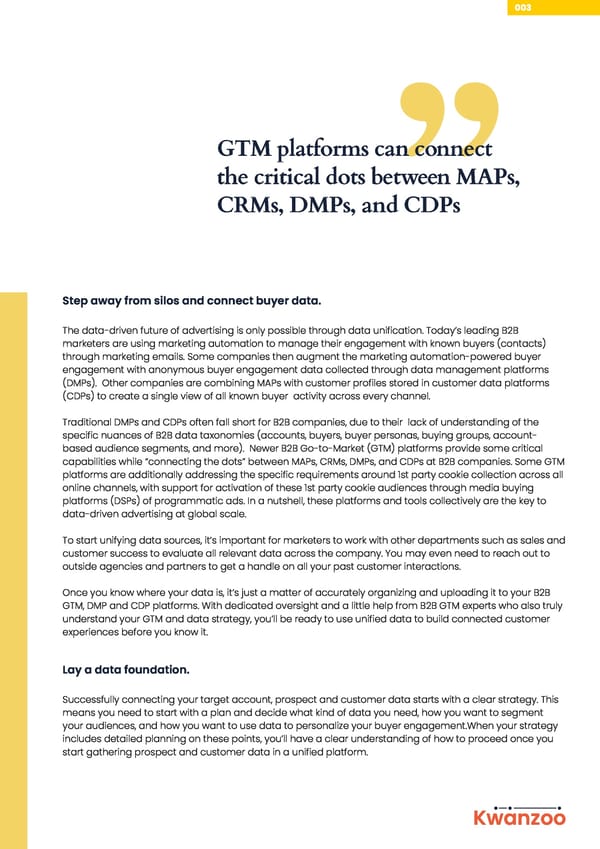
004 Chapter 2: How to create a buyer-centric advertising strategy Start every buyer relationship with consent. As a result of nearly endless choices in the marketplace today, customers are more demanding than ever. In fact, 72% of today’s customers expect companies to understand their needs. That’s why it’s crucial to put customer needs at the center of your business goals. With enough unified data, the right data architecture and taxonomy, and a customer-first mindset, you can create advertising journeys that relate to each buyer’s interests and build trusting relationships over time. When each target buyer, and their associated account has a unified identity across all of your marketing technology, you’ll have the information you need to build B2B marketing strategies based on their (or their persona’s) preferences on every channel. Plus, by delivering relevant content on the right channels at the right time, you can gather buyer engagement data to inform both your marketing programs and sales outreach going forward — it’s a gift that keeps on giving for marketers, sales teams, prospects and customers alike. Think through the best experience for each target buyer & create a personalized journey. Treating each target account, and buyers at that account as an individual is essential. It’s important to be able to deliver different offers and messaging to unique audiences based on their needs. With B2B marketing, it may not always be possible to personalize at the individual buyer level. It can then be very beneficial to personalize to each of the key target buyer personas (e.g. VP of Marketing, CFO, Sales Managers). Through a B2B GTM platform, that is combined with a data lake or customer data platform (CDP), that easily connects into third party marketing and sales data sources, marketers can use data to identify key traits about both prospects and existing buyers at their target accounts. Marketers can use that information to generate target account lists that match their ideal account profile(s) (IAP) for each line-of-business (LOB) within their Company. They can then focus on the right set of prioritized accounts and key target personas for tailored B2B advertising. Targeting accounts and B2B buyers or specific personas (a group of buyers with similar expectations around specific products or solutions) on a 1-to-1 basis is a foundational part of delivering the best experiences to each prospect and customer. With a full understanding of each customer’s interests and past interactions, you can improve experiences by personalizing all of your future interactions specifically to what those prospects and customers want. Kwanzoo
005 Operationalize standardized account and buyer taxonomies, and first party-cookie support. A key challenge for marketers today is the lack of standardized account and buyer taxonomies across the 10s to 100s of marketing, sales and customer success platforms, applications and tools that are in use across B2B companies, whether early stage venture-funded startups, unicorns or more mature mid-market and large enterprise customers. Buyer taxonomies (e.g. personas, seniorities, departments, job functions, and more) often vary by data provider. Account identification varies across sales systems (e.g. CRM, Sales Engagement) and third party data (e.g. Intent and Audience data providers). Typical account identification approaches today do not support account hierarchies, tracking corporate entities versus the line-of-business, tracking engagement or demand at a site location level. Marketers must ask the hard questions of their GTM and ABM platform providers as to how they are addressing these urgent marketer challenges. Leaving them unaddressed can lead to significant disconnects in reports delivered to Sales teams (SDRs, Sales Reps, Account Managers, others). That can additionally translate into lost Sales productivity, and wasted media and marketing program spend. Finally, it is essential that your GTM and ABM platform partners are actively developing solutions, and can advise you on a clear strategy and roadmap for managing all of your account-based audiences, using first-party cookies. They must be able to explain how their platform can help you run omni-channel marketing programs that are designed to track all accounts and individual buyer engagement, using first- party cookies that are owned by your Company, and not any third party technology, data or services provider. Today’s leading marketers are delivering powerful 1-to-1 contextual engagement, including campaigns personalized to topics customers care about most, products/solutions of interest, or content assets that speak to their specific persona. They additionally plan for suppression of ads that don’t apply to certain accounts or target buyers — all based on a unified view of each target account and buyer’s engagement history with the brand. Consider your next steps. Remember, personalized advertising and target account and buyer engagement isn’t just about single moments of connection. It’s really about creating experiences across their buyer journey that shifts, moves, and evolves based on who the account is, the relevant personas at that account, the content they interact with, and what they’re interested in. To truly drive growth with data-driven advertising, you need to have a clear plan for what your next steps are right from the very first buyer interaction at any of your ideal account profile (IAP) accounts. Consider how that first engagement can be a jumping-off point for future interactions and an overall journey personalized to each target persona and buyer. Kwanzoo

006 Chapter 3: How to launch and measure cross-channel campaigns Optimize every campaign with data-driven insights. The future of advertising is all about meeting the right prospective buyer at a target account, or the right buyer at an IAP account, with the right content at the right time on their preferred channels. Data is the key to connecting with customers this way.The sophisticated and impactful campaigns of the future will continuously use data to integrate relevant content throughout a buyer’s ongoing journey with the brand. While artificial intelligence and automation promise the potential for optimizing content for different audiences in real time, based on customers’ actions, to ensure the best outcome, today’s GTM and ABM orchestration and execution platforms continue to require strategic input on messaging from marketing strategists, and the processes require some level of human intelligence and periodic monitoring and intervention to be effective. TTooddaayy ccaammppaaiiggnn ppllaannnniinngg aallwwaayyss ccaallllss ffoorr aalliiggnnmmeenntt wwiitthh bbuussiinneessss oouuttccoommeess aanndd KKPPIIss,, ssuuppppoorrtteedd bbyy ddaattaa.. When building a data-driven campaign, you can begin by analyzing the journeys your target buyers and customers are currently on, and measuring the success of different content and channels throughout those journeys. Advertisers are reaching customers through a multitude of channels and formats. With cross-channel measurement, advertisers can better understand customer preferences and ensure that every message is relevant, authentic, and personalized. Kwanzoo
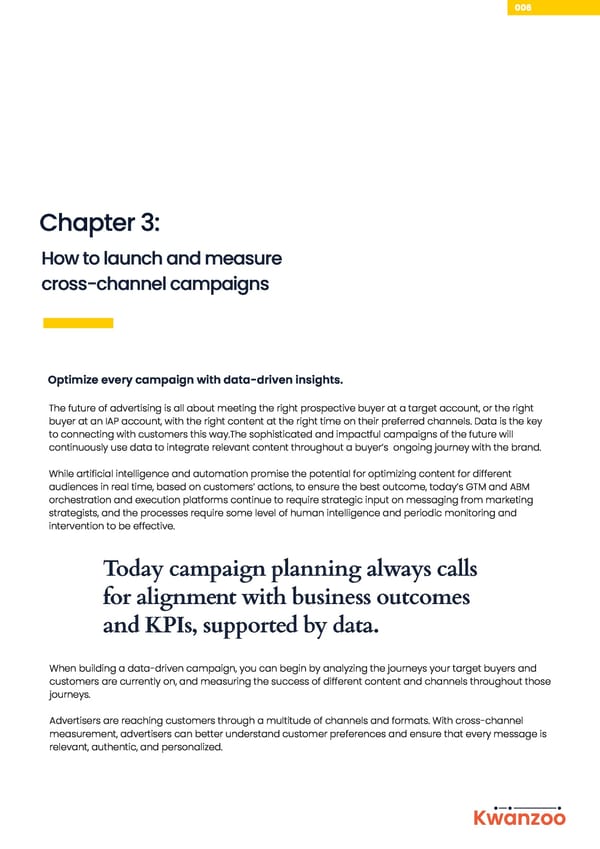
007 CCoonnnneecctt aanndd hhaarrmmoonniizzee aallll ooff yyoouurr mmaarrkkeettiinngg aanndd ccuussttoommeerr ddaattaa ssoouurrcceess tthhrroouugghh aa uunniiffiieedd mmaarrkkeettiinngg ddaattaa mmooddeell.. ” Get efficient marketing insights with automated measurement. As marketing budgets continue to shrink, proving clear value and ROI is more important than ever. With unified marketing data and automation, today’s leading marketers are delivering deep and insightful measurement reports about their advertising campaigns and customer journeys. While it’s still essential to generate leads, it’s becoming increasingly important to track customer-centric metrics — such as individual buyer engagement, both known and anonymous buyers at target accounts. It is important to think beyond landing a deal at a prospect to turn them into a customer, to then consider how to improve metrics around customer satisfaction and customer lifetime value — as well as growth- related metrics — such as return on marketing investment, funnel conversion rate, and sales/revenue — as marketing teams seek insights that can inform improved customer journeys and bottom-line business impact. To prepare your measurement and reporting process for the data-driven future of advertising, you need to connect and harmonize all of your marketing and customer data sources through a unified marketing data model that adapts to any new campaign or channel. A key best practice is to create a standard marketing data taxonomy that you can scale across different business units, regions, and teams. This helps keep the reporting conversation consistent, no matter where it takes place. While artificial intelligence and automation promise to streamline measurement and gain real-time insights, modern marketing requires the best practices insights and human intelligence of strategists within your team, or at your marketing services partners. By evaluating your business goals and your target buyers’ needs, you can better align marketing to business outcomes. By using data as a starting point, you can help create a culture of continuous marketing optimization that benefits both your customers and your quarterly reports. Always find ways to improve. Fundamentally, data is information — and information is insight. Be sure to consistently use your marketing data to see how your advertising is working, and keep track of which parts of your campaign are working well and which parts may not be as successful.With an eye on continuous improvement, you can find ways to create truly compelling and personalized customer campaigns that evolve over time, powered by real-time updates based on your data. Kwanzoo
008 Conclusion The future of advertising is coming at us fast, but with the right data and the right tools, every marketing and brand leader has the opportunity to simplify the process for their team. By informing your marketing with real-time insights from your customers’ preferred channels, you can create compelling journeys that connect with your customers and help your brand stand out. The story of data-driven advertising is still being written, and we want to hear about your story, too. If you have any suggestions about ideas to add to this primer, please reach out to Kwanzoo on LinkedIn or Twitter — and tag your message with the hashtags #accoutbasedGTM Kwanzoo


